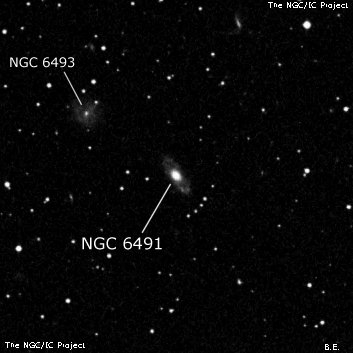NGC/IC Project Restoration Effort
(This is a very very beta version)
NGC6491


Basic Information
Location and Magnitude
Right Ascension: 17:50:0.6
Declination: +61:31:55
Constellation: DRA
Visual Magnitude: 13.6
Historic Information
Discoverer: Swift L.
Year of discovery: 1885
Discovery aperture: 16.0
Observational
Summary description: pF, eS, vF * att, np of 2
Sub-type: Sab
Corwin's Notes
=====
NGC 6491 is probably also NGC 6493. It has seemed "obvious" to all of us for
the nearly 130 years since Swift found his 78th and 79th objects that he must
have seen the two galaxies, UGC 11008 and UGC 11011 near the positions he
gives. This would make U11008 = N6491, and U11011 = N6493. All the recent
catalogues (aside from RC1 which adopted Keenan's ApJ 82, 62, 1935 designation
"N6493A" for UGC 11008; and RNGC which switched the NGC identifications so
that "N6491" = U11011, and "N6493" = U11008) have adopted these IDs. But, as
Steve Gottlieb has recently (December 2014) pointed out, there are problems
with this simple assumption.
First, Swift's position for N6493 is not very good -- it is -17 seconds of
time in RA, and -3 arcminutes in Dec off of UGC 11011, the canonical ID.
Second, the comment "sf of 2" for U11011 is wrong -- it is in fact northeast
of U11008, the canonical N6491. (Similarly, the companion comment "np of 2"
for N6491 is wrong.) Steve suggests that this is probably another case (see
e.g. N6497 = N6498) where Swift added the comments on the relative positions
while he was preparing his list of nebulae for publication. Finally, Steve
had some difficulty seeing the northeastern galaxy with his 18-inch reflector;
it has a much lower surface brightness than the considerably brighter
southwestern object.
So, Steve suggests that Swift's two observations are actually of the same
object, UGC 11008. The descriptions are similar: Swift 1-78 (13 June 1885):
"vvS, pF, vF * in or just in contact with it; np of 2"; and 1-79 (5 June
1885): "F, vvS, R, planetary, F * v nr; sf of 2". Only the star in or near
the object might raise a warning flag as there is no such star near the
brighter galaxy, and two such stars near U11011, either of which Swift might
have seen. Steve suggests instead that Swift might have mistaken the bright
nucleus of U11008 for a star.
I'm pretty well convinced by Steve's argument, though the problem of the
nearby star is a bit bothersome. For that reason alone, I am going to put
colons on Steve's suggested identities, and leave UGC 11011 as a possible
identification for N6493, though with a prominent question mark.
Finally, concerning the visibility of the objects, take a look at the red and
blue DSS2 images using SkyView (http://skyview.gsfc.nasa.gov/). I used a
default field 500 pixels on a side centered on NGC 6491. The difference in
appearance of UGC 11011 between the two images is striking, while the bright
core of UGC 11008 remains essentially unchanged.
Steve's Notes
=====
NGC 6491
18" (7/27/03): fairly faint, small, round, sharply concentrated with a very small bright core and stellar nucleus. The outer halo has a very low surface brightness and core may be offset within the halo. Brightest of a close trio with NGC 6493 3.1' NE and UGC 11007 4.6' NNW.
17.5" (8/4/94): fairly faint, fairly small, round, even concentration to a small bright core, stellar nucleus. Forms a pair with NGC 6493 3.1' ENE. The identifications of NGC 6491 and NGC 6493 are reversed in the RNGC.
17.5" (6/11/88): very faint, very small, slightly elongated. NGC 6493 3.1' NE not visible.



